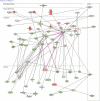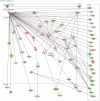A Moderate Blast Exposure Results in Dysregulated Gene Network Activity Related to Cell Death, Survival, Structure, and Metabolism
- PMID: 32174881
- PMCID: PMC7054450
- DOI: 10.3389/fneur.2020.00091
A Moderate Blast Exposure Results in Dysregulated Gene Network Activity Related to Cell Death, Survival, Structure, and Metabolism
Abstract
Blast exposure is common in military personnel during training and combat operations, yet biological mechanisms related to cell survival and function that coordinate recovery remain poorly understood. This study explored how moderate blast exposure influences gene expression; specifically, gene-network changes following moderate blast exposure. On day 1 (baseline) of a 10-day military training program, blood samples were drawn, and health and demographic information collected. Helmets equipped with bilateral sensors worn throughout training measured overpressure in pounds per square inch (psi). On day 7, some participants experienced moderate blast exposure (peak pressure ≥5 psi). On day 10, 3 days post-exposure, blood was collected and compared to baseline with RNA-sequencing to establish gene expression changes. Based on dysregulation data from RNA-sequencing, followed by top gene networks identified with Ingenuity Pathway Analysis, a subset of genes was validated (NanoString). Five gene networks were dysregulated; specifically, two highly significant networks: (1) Cell Death and Survival (score: 42), including 70 genes, with 50 downregulated and (2) Cell Structure, Function, and Metabolism (score: 41), including 69 genes, with 41 downregulated. Genes related to ubiquitination, including neuronal development and repair: UPF1, RNA Helicase and ATPase (UPF1) was upregulated while UPF3 Regulator of Nonsense Transcripts Homolog B (UPF3B) was downregulated. Genes related to inflammation were upregulated, including AKT serine/threonine kinase 1 (AKT1), a gene coordinating cellular recovery following TBIs. Moderate blast exposure induced significant gene expression changes including gene networks involved in (1) cell death and survival and (2) cellular development and function. The present findings may have implications for understanding blast exposure pathology and subsequent recovery efforts.
Keywords: NanoString; RNA-sequencing; blast; gene expression; overpressure.
At least a portion of this work is authored by Katie A. Edwards, Vida Motamedi, Nicole D. Osier, Hyung-Suk Kim, Young-Eun Cho, Chen Lai, Kristine C. Dell, Walter Carr, Peter Walker, Stephen Ahlers, Matthew LoPresti, Angela Yarnell, Anna Tschiffley and Jessica M. Gill on behalf of the U.S. Government and, as regards Katie A. Edwards, Vida Motamedi, Nicole D. Osier, Hyung-Suk Kim, Young-Eun Cho, Chen Lai, Kristine C. Dell, Walter Carr, Peter Walker, Stephen Ahlers, Matthew LoPresti, Angela Yarnell, Anna Tschiffley and Jessica M. Gill and the U.S. Government, is not subject to copyright protection in the United States. Foreign and other copyrights may apply.
Figures


Similar articles
-
Moderate blast exposure alters gene expression and levels of amyloid precursor protein.Neurol Genet. 2017 Sep 27;3(5):e186. doi: 10.1212/NXG.0000000000000186. eCollection 2017 Oct. Neurol Genet. 2017. PMID: 28975156 Free PMC article.
-
Moderate blast exposure results in increased IL-6 and TNFα in peripheral blood.Brain Behav Immun. 2017 Oct;65:90-94. doi: 10.1016/j.bbi.2017.02.015. Epub 2017 Feb 21. Brain Behav Immun. 2017. PMID: 28232173 Free PMC article.
-
Blast exposure results in tau and neurofilament light chain changes in peripheral blood.Brain Inj. 2020 Jul 28;34(9):1213-1221. doi: 10.1080/02699052.2020.1797171. Epub 2020 Aug 5. Brain Inj. 2020. PMID: 32755419
-
Cumulative Blast Exposure Estimate Model for Special Operations Forces Combat Soldiers.J Neurotrauma. 2023 Feb;40(3-4):318-325. doi: 10.1089/neu.2022.0075. Epub 2022 Sep 9. J Neurotrauma. 2023. PMID: 35934872
-
A Comprehensive Review of Experimental Rodent Models of Repeated Blast TBI.Front Neurol. 2019 Sep 27;10:1015. doi: 10.3389/fneur.2019.01015. eCollection 2019. Front Neurol. 2019. PMID: 31611839 Free PMC article. Review.
Cited by
-
Association of MOS-Based Blast Exposure With Medical Outcomes.Front Neurol. 2020 Jul 31;11:619. doi: 10.3389/fneur.2020.00619. eCollection 2020. Front Neurol. 2020. PMID: 32849167 Free PMC article.
-
Traumatic MicroRNAs: Deconvolving the Signal After Severe Traumatic Brain Injury.Cell Mol Neurobiol. 2023 Apr;43(3):1061-1075. doi: 10.1007/s10571-022-01254-z. Epub 2022 Jul 19. Cell Mol Neurobiol. 2023. PMID: 35852739 Free PMC article. Review.
-
Chronic elevation of plasma vascular endothelial growth factor-A (VEGF-A) is associated with a history of blast exposure.J Neurol Sci. 2020 Oct 15;417:117049. doi: 10.1016/j.jns.2020.117049. Epub 2020 Jul 18. J Neurol Sci. 2020. PMID: 32758764 Free PMC article.
-
The Chronic Effects of a Single Low-Intensity Blast Exposure on Phosphoproteome Networks and Cognitive Function Influenced by Mutant Tau Overexpression.Int J Mol Sci. 2024 Mar 15;25(6):3338. doi: 10.3390/ijms25063338. Int J Mol Sci. 2024. PMID: 38542311 Free PMC article.
-
DNA Methylation Patterns of Chronic Explosive Breaching in U.S. Military Warfighters.Front Neurol. 2020 Oct 23;11:1010. doi: 10.3389/fneur.2020.01010. eCollection 2020. Front Neurol. 2020. PMID: 33192958 Free PMC article.
References
-
- Tenielien T, Jaycox L. Invisible Wounds of War: Psychological and Cognitive Injuries, Their Consequences, and Services to Assist Recovery. Santa Monica, CA: RAND Center for Military Health Policy Research; (2008). 10.1037/e527612010-001 - DOI
LinkOut - more resources
Full Text Sources
Research Materials
Miscellaneous

